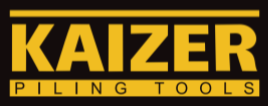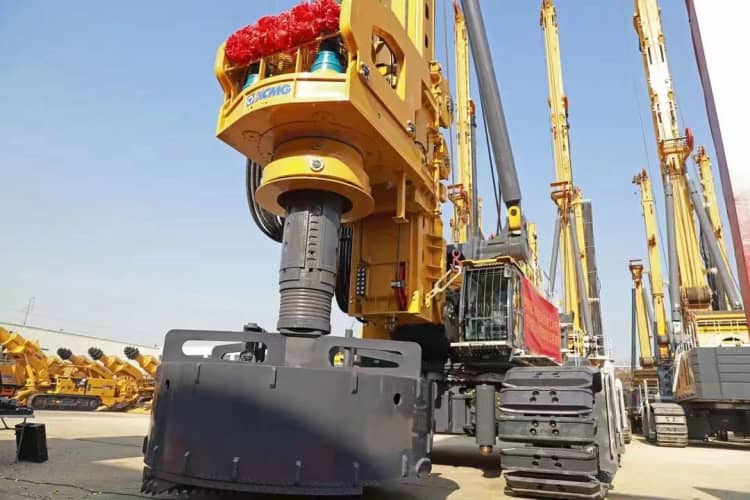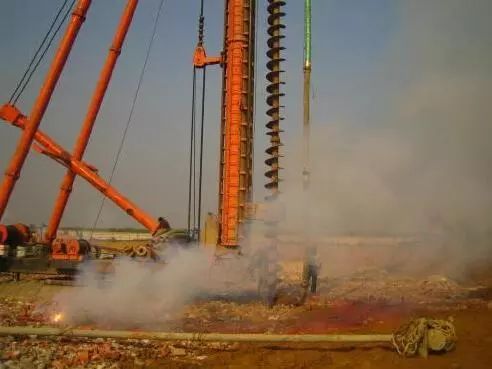1. Common quality problems during construction
(1) Pipe blockage: This manifests as concrete blocking the pumping pipeline or drill pipe during the concrete pouring process. There are many reasons for pipe blockage, which may be related to the effect of the mix ratio on the compactness of concrete. If the concrete slump is too small, the fluidity of the mixture in the delivery pipeline will be reduced. If the slump is too large, segregation and water seepage will occur.
(2) Drill stuck: When pouring concrete piles, the drill rod lowering speed is not well controlled, which may cause the drilled cuttings to not be taken out of the hole in time and accumulate between the drill rod and the hole wall, resulting in drill stuck or hard foreign objects and large stones in the soil layer at the drilling location.
(3) Incomplete pile head: The quality problem of the pile head is mainly caused by the technicians’ lack of familiarity with the operation method and the failure to control the speed of the drill rod. This may be due to the failure to remove the drill cuttings in the pile mouth and the borehole in time, or the inability to open the air valve freely. In addition, when too much mud is generated on the pile top, the over-pouring removal method is not used, which may also lead to an incomplete pile head.
(4) Unqualified quality of steel cage: mainly manifested in deformation of the steel cage, failure to lower the steel cage into place, and sinking of the steel cage after lowering.
1) Deformation of steel cage: manifested in serious deformation and loosening of the stirrups of the steel cage during lifting or insertion.
2) Failure to lower the steel cage into place: manifested in the failure to lower the steel cage smoothly during the lifting and insertion process, or failure to lower the steel cage to the designed elevation as required by the design, and the steel cage is seriously exposed for too long.
3) Sinking of the steel cage after lowering: manifested in the complete submersion of the entire steel cage into the concrete after the steel cage is lowered.
(5) Broken piles, reduced diameter, and pile body defects: Too fast acceleration of the drilling rod will result in the amount of concrete in the delivery pipe not meeting the construction requirements. If the concrete does not fill the borehole, the drilling rod will generate negative pressure during the lifting of the drilling rod, which will cause the hole wall to collapse, and then the broken pile will occur. If the negative pressure is too large, it may also affect the adjacent piles.
2. Common quality problems after pile formation
(1) Pile deflection: This is manifested in the fact that the pile foundation deflection exceeds the allowable value in the specification during the setting out process of the pile foundation cap after the pile is completed.
(2) Mud inclusion in the pile body: The main manifestation is that after the pile head is broken, it is found that the concrete of the pile body in the pile head section is seriously mixed with mud blocks (after digging and inspection, the depth of some mud inclusions can reach about 3m). The second manifestation is that during the low-strain inspection of the pile foundation, the integrity of some piles was poor. The excavation inspection of the piles with serious problems revealed that there was mud in the pile body in the problem area. According to the overall inspection on site, mud inclusions mostly occur in the pile body section, and a small amount occurs in the middle section of the pile body.
(3) The pile body is hollow: the main symptom is that after the pile head is broken, it is found that there are round holes in the pile body concrete in the pile head section with the same diameter as the vibrating tube, and the hole depths are different (after inspection, some holes are as deep as 3 m above). The second manifestation is that during the low-strain inspection of the pile foundation, the integrity of the pile body is poor. When some problem piles continue to break the pile head, the pile body is often hollow. According to the overall inspection on-site, the hollowing of the pile body occurs only in the section of the pile body.
(4) Missing steel bars at the anchorage end of the pile foundation: no steel bars were found after the pile head was broken, or the length of the steel bars in the anchorage section of the steel cage seriously did not meet the design requirements.
Quality Problem Prevention Measures
(1) Before construction, the construction unit must carefully prepare a long spiral construction plan, and the supervision unit must carefully review and approve the quality control and management measures and systems in the plan, and strictly supervise the implementation.
(2) Before drilling the pile foundation, the pile position mark positioning and the ground elevation of the hole mouth must be carefully checked; if the on-site pile position mark is damaged during the drilling process or due to other operations, the mark must be carefully re-measured and re-arranged, and it must not be arbitrarily straightened and restored. When drilling, check to ensure that the drill rod and the pile position mark are aligned before drilling. This prevents the deviation of the pile foundation.
(3) Before drilling the pile foundation, check the verticality of the drill rod. Drill only after confirming that it is vertical. Check at any time during the process and adjust it in time if deviation is found, to prevent the tilt of the pile foundation. The verticality of the drill rod can be checked using a level on the drill tube. If there is no level, a plumb bob must be set on the front and side of the drill tube for inspection.
(4) Before and after the concrete pouring of the pile foundation, the pumping pipeline and the drill pipe must be cleaned and the residue removed in time; at the same time, the slump of the concrete entering the site and the concrete supply status must be carefully checked and controlled. Ensure the quality of the poured concrete and prevent the concrete from blocking the pipe.
(5) During the drilling and concrete pouring of the pile foundation, a small excavator must be equipped on-site to clean the pile core soil around the pile mouth in time to prevent the soil from being swept into the pile concrete during subsequent operations, causing mud to be trapped at the pile end.
(6) During the concrete pouring of the pile, the concrete pumping pressure must be fully utilized to push the drill rod upward, or the drill rod must be lifted slowly and at a uniform speed synchronized with the speed of the concrete pumping. The drill must not be lifted quickly to cause the diameter to shrink.
(7) During the steel cage’s processing, the stirrup jumping situation must be carefully checked and controlled, and strict acceptance must be carried out. During the transportation process, the cage must be hoisted and must not be dragged on the ground at will. This is to prevent the stirrups from loosening and deforming during transportation and sinking.
(8) After the concrete pouring of the pile foundation is completed, the steel cage should be lowered in time to prevent the concrete from losing water or initial setting due to a long time, which will affect the lowering. At the same time, if it is found that the concrete has dried out prematurely due to soil absorption and affects the lowering of the steel cage, the mixing station should be notified in time to adjust and increase the slump of the concrete.
(9) During the sinking of the steel cage, ensure that the cage is vertical and centered to avoid the cage tip inserting into the hole wall and bringing in mud blocks, causing mud to be trapped in the pile concrete. At the same time, unless there are special circumstances, try to minimize the vibration and directly use the steel cage and vibrator to sink quickly, to avoid excessive vibration causing the aggregate to sink and concentrate, and the concrete segregation and fluidity to weaken, which will affect the smooth sinking of the steel cage.
(10) After the steel cage is sunk to the designed elevation, a bracket should be set at the hole mouth to fix it to prevent the steel cage from continuing to sink; after the steel cage is sunk in place, the vibrator should be turned on in time, and the vibrator rod should be slowly raised while vibrating to ensure that the concrete is vibrated densely and does not form a hollow.
(11) During the quality control of pile construction, the construction surface should be flat and compacted; the drilling rig should be stable and the drill rod should be vertical; the verticality of the drill rod should be corrected at any time using the drilling rig’s plumb system; a slump meter should be used to measure and ensure the workability of the concrete; and the ratio of the actual pouring volume to the calculated value should be within a certain range.
===Thanks ===



